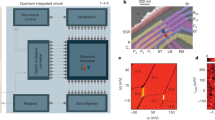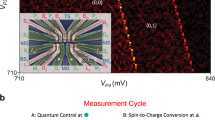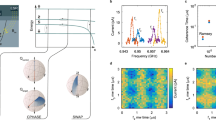Abstract
Quantum computation requires qubits that can be coupled in a scalable manner, together with universal and high-fidelity one- and two-qubit logic gates1,2. Many physical realizations of qubits exist, including single photons3, trapped ions4, superconducting circuits5, single defects or atoms in diamond6,7 and silicon8, and semiconductor quantum dots9, with single-qubit fidelities that exceed the stringent thresholds required for fault-tolerant quantum computing10. Despite this, high-fidelity two-qubit gates in the solid state that can be manufactured using standard lithographic techniques have so far been limited to superconducting qubits5, owing to the difficulties of coupling qubits and dephasing in semiconductor systems11,12,13. Here we present a two-qubit logic gate, which uses single spins in isotopically enriched silicon14 and is realized by performing single- and two-qubit operations in a quantum dot system using the exchange interaction, as envisaged in the Loss–DiVincenzo proposal2. We realize CNOT gates via controlled-phase operations combined with single-qubit operations. Direct gate-voltage control provides single-qubit addressability, together with a switchable exchange interaction that is used in the two-qubit controlled-phase gate. By independently reading out both qubits, we measure clear anticorrelations in the two-spin probabilities of the CNOT gate.
This is a preview of subscription content, access via your institution
Access options
Subscribe to this journal
Receive 51 print issues and online access
$199.00 per year
only $3.90 per issue
Buy this article
- Purchase on Springer Link
- Instant access to full article PDF
Prices may be subject to local taxes which are calculated during checkout




Similar content being viewed by others
References
DiVincenzo, D. P. The physical implementation of quantum computation. Fortschr. Phys. 48, 771–783 (2000)
Loss, D. & DiVincenzo, D. P. Quantum computation with quantum dots. Phys. Rev. A 57, 120–126 (1998)
Kok, P. et al. Linear optical quantum computing with photonic qubits. Rev. Mod. Phys. 79, 135–174 (2007)
Brown, K. R. et al. Single-qubit-gate error below 10−4 in a trapped ion. Phys. Rev. A 84, 030303 (2011)
Barends, R. et al. Superconducting quantum circuits at the surface code threshold for fault tolerance. Nature 508, 500–503 (2014)
Waldherr, G. et al. Quantum error correction in a solid-state hybrid spin register. Nature 506, 204–207 (2014)
Dolde, F. et al. High-fidelity spin entanglement using optimal control. Nature Commun. 5, 3371 (2014)
Muhonen, J. T. et al. Storing quantum information for 30 seconds in a nanoelectronic device. Nature Nanotechnol. 9, 986–991 (2014)
Veldhorst, M. et al. An addressable quantum dot qubit with fault-tolerant fidelity. Nature Nanotechnol. 9, 981–985 (2014)
Fowler, A., Marlantoni, M., Martinis, J. M. & Cleland, A. N. Surface codes: towards practical large-scale quantum computation. Phys. Rev. A 86, 032324 (2012)
Shulman, M. D. et al. Demonstration of entanglement of electrostatically coupled singlet-triplet qubits. Science 336, 202–205 (2012)
Nowack, K. C. et al. Single-shot correlations and two-qubit gate of solid-state spins. Science 333, 1269–1272 (2011)
Brunner, R. et al. Two-qubit gate of combined single-spin rotation and interdot exchange in a double quantum dot. Phys. Rev. Lett. 107, 146801 (2011)
Itoh, K. M. & Watanabe, H. Isotope engineering of silicon and diamond for quantum computing and sensing applications. Mater. Res. Soc. Commun. 4, 143–157 (2014)
Koppens, F. H. L. et al. Driven coherent oscillations of a single electron spin in a quantum dot. Nature 442, 766–771 (2006)
Petta, J. R. et al. Coherent manipulation of coupled electron spins in semiconductor quantum dots. Science 309, 2180–2184 (2005)
Medford, J. et al. Self-consistent measurement and state tomography of an exchange-only spin qubit. Nature Nanotechnol. 8, 654–659 (2013)
Maune, B. M. et al. Coherent singlet-triplet oscillations in a silicon-based double quantum dot. Nature 481, 344–347 (2012)
Kawakami, E. et al. Electrical control of a long-lived spin qubit in a Si/SiGe quantum dot. Nature Nanotechnol. 9, 666–670 (2014)
Meunier, T., Calado, V. E. & Vandersypen, L. M. K. Efficient controlled-phase gate for single-spin qubits in quantum dots. Phys. Rev. B 83, 121403(R) (2011)
Dehollain, J. P. et al. Nanoscale broadband transmission lines for spin qubit control. Nanotechnology 24, 015202 (2013)
Angus, S. J., Ferguson, A. J., Dzurak, A. S. & Clark, R. G. Gate-defined quantum dots in intrinsic silicon. Nano Lett. 7, 2051–2055 (2007)
Elzerman, J. M. et al. Single-shot read-out of an individual electron spin in a quantum dot. Nature 430, 431–435 (2004)
Yang, C. H. et al. Spin-valley lifetimes in a silicon quantum dot with tunable valley splitting. Nature Commun. 4, 2069 (2013)
Ghosh, J. et al. High-fidelity controlled-σZ gate for resonator-based superconducting quantum computers. Phys. Rev. A 87, 022309 (2013)
Dial, O. E. et al. Charge noise spectroscopy using coherent exchange oscillations in a singlet-triplet qubit. Phys. Rev. Lett. 110, 146804 (2013)
Yang, C. H. et al. Charge state hysteresis in semiconductor quantum dots. Appl. Phys. Lett. 105, 183505 (2014)
Acknowledgements
We thank S. Bartlett for discussions and C. M. Cheng for contributions to the preparation of the experimental setup. We acknowledge support from the Australian Research Council (CE11E0001017), the US Army Research Office (W911NF-13-1-0024) and the NSW Node of the Australian National Fabrication Facility. M.V. acknowledges support from the Netherlands Organization for Scientific Research (NWO) through a Rubicon Grant. The work at Keio was supported in part by the Grant-in-Aid for Scientific Research by MEXT, in part by NanoQuine, in part by FIRST and in part by the JSPS Core-to-Core Program.
Author information
Authors and Affiliations
Contributions
M.V., C.H.Y. and J.C.C.H. performed the experiments. M.V. and F.E.H. fabricated the devices. K.M.I. prepared and supplied the 28Si epilayer wafer. W.H., J.P.D., J.T.M., S.S and A.L. contributed to the preparation of the experiments. M.V., C.H.Y., A.M. and A.S.D. designed the experiment and discussed the results. M.V. analysed the results. M.V. and A.S.D. wrote the manuscript with input from all co-authors.
Corresponding authors
Ethics declarations
Competing interests
The authors declare no competing financial interests.
Supplementary information
Supplementary Information
This file contains Supplementary Methods, Text and Data, Supplementary Figures 1-7 and Supplementary References. (PDF 759 kb)
Rights and permissions
About this article
Cite this article
Veldhorst, M., Yang, C., Hwang, J. et al. A two-qubit logic gate in silicon. Nature 526, 410–414 (2015). https://doi.org/10.1038/nature15263
Received:
Accepted:
Published:
Issue Date:
DOI: https://doi.org/10.1038/nature15263
This article is cited by
-
Reducing charge noise in quantum dots by using thin silicon quantum wells
Nature Communications (2023)
-
Compilation and scaling strategies for a silicon quantum processor with sparse two-dimensional connectivity
npj Quantum Information (2023)
-
A solid-state quantum microscope for wavefunction control of an atom-based quantum dot device in silicon
Nature Electronics (2023)
-
Simultaneous single-qubit driving of semiconductor spin qubits at the fault-tolerant threshold
Nature Communications (2023)
-
Cryogenic memory technologies
Nature Electronics (2023)
Comments
By submitting a comment you agree to abide by our Terms and Community Guidelines. If you find something abusive or that does not comply with our terms or guidelines please flag it as inappropriate.



